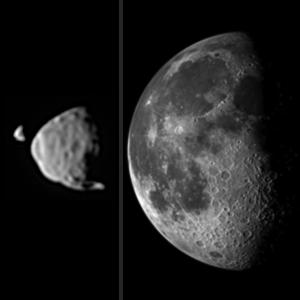Moons of Mars
Moons of Mars
The Martian system includes two small moons, Phobos and Deimos, which orbit the planet Mars. These moons are among the smallest in the Solar System, with Phobos being the larger of the two. Their discovery in 1877 by astronomer Asaph Hall marked a significant milestone in the study of the Martian system. This article provides an overview of the characteristics, origins, and exploration of Mars' moons.
Discovery and Naming[edit | edit source]
Asaph Hall discovered Phobos and Deimos over the course of a week in August 1877, using the 26-inch refractor telescope at the United States Naval Observatory. Hall named the moons after the characters Phobos (fear) and Deimos (terror) from Greek mythology, who were the sons of Ares (the Greek god of war) and Aphrodite. Given that Ares is the Greek counterpart to the Roman god Mars, the names fittingly reflect the martial theme.
Physical Characteristics[edit | edit source]
Phobos[edit | edit source]
Phobos is the larger and closer of the two moons to Mars, with an irregular shape and dimensions of approximately 22.2 × 20.8 × 18.6 kilometers. Its rapid orbital period of about 7.66 hours means it orbits Mars faster than Mars rotates on its axis, making it the only moon in the Solar System to rise in the west and set in the east. Phobos is heavily cratered and features a prominent impact crater named Stickney, which is nearly half the size of the moon itself. The surface of Phobos is also covered in fine dust and loose rocks, and it has grooves and streaks that suggest structural stress.
Deimos[edit | edit source]
Deimos, the smaller and more distant moon, has a smoother appearance and measures approximately 12 × 12 × 10 kilometers. Its orbital period is about 30.3 hours, which is slower than the rotation period of Mars, resulting in a more typical rising and setting from the Martian surface. Deimos is less cratered than Phobos and lacks any large impact features. Its surface is also coated with a layer of regolith, similar to Phobos, but its features are less pronounced.
Origin[edit | edit source]
The origin of Mars' moons is a subject of debate among scientists. The prevailing theories suggest that Phobos and Deimos are either captured asteroids from the asteroid belt or that they were formed from debris ejected into Mars' orbit following a massive impact. The captured asteroid theory is supported by their irregular shapes and composition, which is similar to that of C-type asteroids. However, their stable, almost circular orbits are more consistent with an origin as impact debris.
Exploration[edit | edit source]
Mars' moons have been the subject of scientific interest since their discovery. Several missions to Mars have provided close-up images and data on Phobos and Deimos, including the Viking orbiters, Mars Global Surveyor, Mars Express, and Mars Reconnaissance Orbiter. In the future, missions specifically targeting these moons, such as the proposed Phobos And Deimos & Mars Environment (PADME) mission, aim to further our understanding of their nature and origin.
Significance[edit | edit source]
The moons of Mars hold significant interest for scientific research and future space exploration. Understanding their composition and origin can provide insights into the history of the Martian system and the processes that shape moons and planets. Additionally, Phobos, in particular, has been discussed as a potential base for human exploration of Mars due to its low gravity and proximity to the Martian surface.
Navigation: Wellness - Encyclopedia - Health topics - Disease Index - Drugs - World Directory - Gray's Anatomy - Keto diet - Recipes
Search WikiMD
Ad.Tired of being Overweight? Try W8MD's physician weight loss program.
Semaglutide (Ozempic / Wegovy and Tirzepatide (Mounjaro) available.
Advertise on WikiMD
WikiMD is not a substitute for professional medical advice. See full disclaimer.
Credits:Most images are courtesy of Wikimedia commons, and templates Wikipedia, licensed under CC BY SA or similar.
Contributors: Prab R. Tumpati, MD





